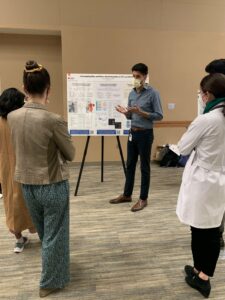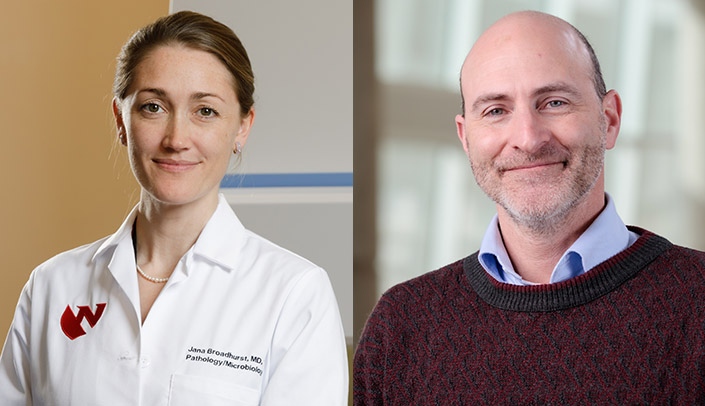
A #PharmToExamTable question about cephalosporin use, answered by Ken Chen, PharmD, a 2021 Graduate of UNMC College of Pharmacy.
(Reviewed by Andrew Watkins, PharmD)
Cefadroxil, a semisynthetic oral first-generation cephalosporin, has been available for over 40 years, with a patent in 1967 and approval for medical use in 1978. It works by inhibiting bacterial cell wall synthesis via binding to one or more of the penicillin-binding proteins (PBPs), which in turn inhibits the final step of peptidoglycan synthesis in bacterial cell walls, thus inhibiting cell wall biosynthesis. The major adverse effects of cefadroxil involve the gastrointestinal tract (dyspepsia, nausea and vomiting, diarrhea) and skin (hypersensitivity reactions in the form of rash, urticaria, angioedema, and pruritus) (1).
Cefadroxil vs. Cephalexin
In terms of pharmacokinetics, cefadroxil is similar to cephalexin, a widely-used first-generation oral cephalosporin. Both drugs are readily absorbed after oral administration and primarily excreted unchanged in the urine. The usual dosing of cefadroxil in patients with normal renal function is 1 to 2 g daily in a single or divided dose compared to cephalexin which may dosed at 250 mg to 1 g every 6 hours. In patients with a urinary tract infection (UTI), cefadroxil and cephalexin may be given as low as once and twice daily, respectively (1,2). The decreased frequency of administration of cephalexin results in significant improvement of patient’s adherence to the medication. With one study noting up to a 30% absolute increase in adherence associated with twice-daily dosing, compared with more frequent administration (3).
Cefadroxil may be administered less frequently compared with cephalexin due to its elimination half-life (t1/2). The serum t1/2 of cefadroxil ranges from 1.1 to 2 hours in adults with normal renal function (4-10). Barbhaiya et al. examined the pharmacokinetics of cefadroxil and cephalexin following single oral doses of either 250, 500 or 1000 mg to a total of 36 healthy volunteers (4). Although values for the peak concentrations (Cmax) for cefadroxil were lower than that of cephalexin, the elimination t1/2 of cefadroxil (~2 hours) was significantly longer than that of cephalexin (~1 hour). Hartstein et al. reported that after equivalent oral dosages, concentrations of cefadroxil in serum and urine were higher and more sustained than were those of cephalexin (11). The longer t1/2 results in a longer time period greater than MIC for cefadroxil compared with an equivalent dose of cephalexin. The cefadroxil concentration in
urine was maintained well above the MIC of all organisms tested for 12+ hours (11). The pharmacokinetic properties of cefadroxil are supportive of the development of clinical efficacy data which could indicate that cefadroxil could be administered at 12-hour intervals.
Can We Use Cefadroxil for MSSA Bacteremia?
Early oral stepdown therapy has been studied in patients with Methicillin-susceptible or Methicillin-resistant Staphylococcus aureus bacteremia who have achieved clinically stable status and received appropriate intravenous antibiotics for 7 to 10 days. One retrospective cohort study (n=100) evaluating the safety of early oral antibiotic switch (prior to 14 days) for low-risk Methicillin-susceptible Staphylococcus aureus bacteremia utilized beta-lactam therapy as the main (72/84, 86%) oral drug of choice (13). Of the 72 patients who received oral beta-lactam therapy, only 7 patients used cephalexin, while 60 patients used flucloxacillin and 5 patients used other beta-lactams. The study was unable to identify a statistical difference between early switch to oral beta-lactam therapy in terms of blood culture relapse, readmission related to Staphylococcus bacteremia, or mortality (13).
Conclusions
Due to the longer elimination t1/2 of cefadroxil compared with cephalexin, cefadroxil can be given less frequently. There is insufficient information to definitively comment on the practice of using oral beta-lactam as a stepdown therapy in patients with Staphylococcus aureus bacteremia.
References
- Cefadroxil [package insert]. Hyderabad, India: Aurobindo Pharma Limited; 2019. https://dailymed.nlm.nih.gov/dailymed/drugInfo.cfm?setid=7bb90096-14d3-400e-94d3-048bff6b1292.
- Cefadroxil. In: Lexi-Drugs Online. Hudson (OH): Lexi-Comp, Inc.; [updated 4/6/21; accessed 4/25/21]. https://online-lexi-com/lco/action/doc/retrieve/docid/patch_f/6549?cesid=0L41TfVcSAf&searchUrl=%2Flco%2Faction%2Fsearch%3Fq%3Dcefadroxil%26t%3Dname%26va%3Dcefadroxil.
- Sclar DA, Tartaglione TA, Fine MJ. Overview of issues related to medical compliance with implications for the outpatient management of infectious diseases. Infect Agents Dis. 1994;3(5):266-273.
- Barbhaiya RH. A pharmacokinetic comparison of cefadroxil and cephalexin after administration of 250, 500 and 1000 mg solution doses. Biopharm Drug Dispos. 1996;17(4):319-330.
- Pfeffer M, Jackson A, Ximenes J, et al. Comparative human oral clinical pharmacology of cefadroxil, cephalexin, and cephradine. Antimicrob Agents Chemother. 1977;11:331-338.
- Marino EL, Dominguez-Gil A. Influence of dose on the pharmacokinetics of cefadroxil. Eur J Clin Pharmacol. 1980;18:505-509.
- Humbert G, Leroy A, Fillastre JP, et al. Pharmacokinetics of cefadroxil in normal subjects and in patients with renal insufficiency. Infection.1980; 8(Suppl 5):S598-602.
- Lode H, Stahlmann R, Koeppe P. Comparative pharmacokinetics of cephalexin, cefaclor, cefadroxil, and CGP 9000. Antimicrob Agents Chemother. 1979;16:1-6.
- La Rosa F, Ripa S, Prenna M, et al. Pharmacokinetics of cefadroxil after oral administration in humans. Antimicrob Agents Chemother. 1982;21:320-322.
- Welling PG, Selen A, Pearson JG, et al. A pharmacokinetic comparison of cephalexin and cefadroxil using HPLC assay procedures. Biopharm Drug Dispos. 1985;6:147-157.
- Hartstein AI, Patrick KE, Jones SR, Miller MJ, Bryant RE. Comparison of pharmacological and antimicrobial properties of cefadroxil and cephalexin. Antimicrob Agents Chemother. 1977;12(1):93-97.
- Dagher M, Fowler VG Jr, Wright PW, Staub MB. A Narrative Review of Early Oral Stepdown Therapy for the Treatment of Uncomplicated Staphylococcus aureus Bacteremia: Yay or Nay?. Open Forum Infect Dis. 2020;7(6):ofaa151.
- Bupha-Intr O, Blackmore T, Bloomfield M. Efficacy of Early Oral Switch with β-Lactams for Low-Risk Staphylococcus aureus Bacteremia. Antimicrob Agents Chemother. 2020;64(7):e02345-19.











Recent Comments